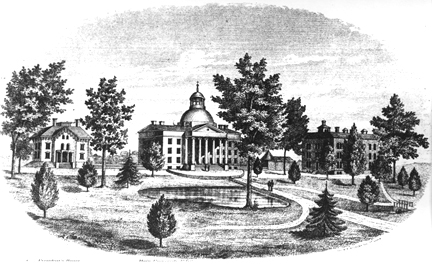Holdings:
* UM-System
* Columbia

Jesse Hall
(University Archives, C:1/40/1)

Contemporary artist's rendering of the MU Columbia campus in 1872, shortly after completion of Switzler Hall (then known as the "Agricultural Building") seen on the right above.
(University Archives, C:0/49/2)
Click here to see a larger version of the image above.
In February of 1839, the Geyer Act was passed by the Missouri State General Assembly. This legislation ordered, in part, that "A University is hereby instituted in this State." At this time, the University of Missouri was the only public institution of higher learning west of the Mississippi River. It was determined that, for greatest ease of access, the University should be located in one of several central Missouri counties, at a site near what was then the State's main artery of commerce and transportation, the Missouri River. A spirited competition ensued among several of the counties under consideration to raise the most in cash and land "subscriptions" to provide for construction and support of the University. Boone County was able to amass the greatest total, just over $118,000, and its leading city, Columbia, was therefore chosen as the site of the University of Missouri.
During the Civil War, several efforts were made by supporters of the Federal Union to move the University to a more "loyal" area of Missouri. These initiatives were all successfully resisted by adherents of the Columbia site. An almost equally contentious debate developed over where to place a college of Agriculture and "Mechanic Arts" which was provided for under provisions of the Morrill Act of 1862. After much rancor (including a renewed campaign to move the entire University), a compromise was finally reached in early 1870. It called for placement of the new college on the Columbia campus and for the creation of a School of Mines and Metallurgy, as a part of the University but with its campus located in Rolla, Missouri. Faculty and students of this remote institution were to enjoy equal standing with their contemporaries at the Columbia campus.
The University of Missouri grew over the following decades to hold a place of regional and national distinction. It became a member of the Association of American Universities early in the existence of that organization of leading graduate and research institutions. Among the most prominent of the University's professional schools were the College of Agriculture, with its statewide extension service, and the School of Journalism, which was the first of its kind established.
In the early 1960s, an effort was made to enable the University to more fully address the higher education needs of Missouri's two major metropolitan centers: St Louis and Kansas City. With this goal of improving access for the residents of these cities, the University of Missouri implemented a plan to expand to a four-campus system, with campuses of the system at Columbia, Rolla, St Louis, and Kansas City. In the spring of 1963, the trustees of the University of Kansas City transferred control of their institution to the Board of Curators and President of the University of Missouri. The School Board of Normandy School District also donated to the University the buildings and grounds of a former country club to be the St Louis campus of the growing system.
The University Board of Curators and President retain overall authority and responsibility for all of the University system; however, they do appoint Chancellors to exercise local control of each branch, including the original campus at Columbia. Offices of the Central Administration are located in Columbia, at University Hall, separate from the University of Missouri-Columbia Administration's offices in Jesse Hall.
![]() Significant Dates in the History of MU
Significant Dates in the History of MU
![]() History of the Board of Curators
History of the Board of Curators
![]() Board of Curators Membership List
Board of Curators Membership List
Warning: This table is a large file (43kb)
For additional historical information, see History, Facts & Traditions [originally located at http://missouri.edu/about/history]
